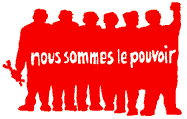6 October 2008
Ateliers Populaires

Anti-Nazism and the Ateliers Populaires: The Memory of Nazi Collaboration in the Posters of Mai ’68 is an excellent essay on the origins and context of the Ateliers Populaires, a collective poster workshop supporting the striking students and workers in France. Among the things I learned:
- There were several Ateliers Populaires in several cities in France. Paris alone had 6.
- The posters appeared in something of a vacuum, and were all the more shocking because of this. Political posters had not been seen on the streets in 20 years.
- The first posters were originally intended as fine art prints for sale to raise money for the striking workers, not as street art, and were originally printed by offset lithography, a more labor intensive process. These were taken out to the streets by popular demand where they inspired others to do the same.
- The style and simplicity of the designs was a function of both the medium and the conditions of production: the low-tech, improvised silkscreen apparatus and the incredible speed at which they were produced.
- The cheap newsprint paper they printed on were remnants donated by newspaper printers, who couldn't use the last bits of their paper rolls.
- Anyone could submit a design or slogan and designs were argued over collectively.
- Despite the progressive politics, the role of women in the studios was rather regressive.
- In some cases, the artists chose a more provocative poster idea over a more politically sensitive one. The posters comparing the French security apparatus to the Nazis and their tactics were particularly problematic and incendiary.

